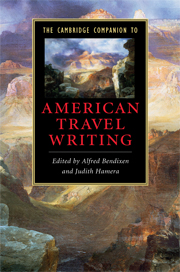Book contents
- Frontmatter
- Introduction: new worlds and old lands - the travel book and the construction of American identity
- Part I Confronting the American landscape
- Part II Americans abroad
- 6 American travel books about Europe before the Civil War
- 7 Americans in Europe from Henry James to the present
- 8 Americans in the Holy Land, Israel, and Palestine
- 9 Americans in the larger world: beyond the Pacific coast
- 10 South of the border: American travel writing in Latin America
- Part III Social scenes and American sites
- Chronology
- Further Reading
- Index
10 - South of the border: American travel writing in Latin America
from Part II - Americans abroad
Published online by Cambridge University Press: 28 March 2009
- Frontmatter
- Introduction: new worlds and old lands - the travel book and the construction of American identity
- Part I Confronting the American landscape
- Part II Americans abroad
- 6 American travel books about Europe before the Civil War
- 7 Americans in Europe from Henry James to the present
- 8 Americans in the Holy Land, Israel, and Palestine
- 9 Americans in the larger world: beyond the Pacific coast
- 10 South of the border: American travel writing in Latin America
- Part III Social scenes and American sites
- Chronology
- Further Reading
- Index
Summary
Writings about American travel to South America are neither as numerous nor as distinguished as the writings about American travel to Europe. Henry James never luxuriated in Buenos Aires; Mark Twain was never led astray in Rio de Janeiro. One consideration that immediately arises is the question of canon. There are some great travel books by Americans, ranging from William Herndon's Exploration of the Valley of the Amazon, 1851-2 (1854) to Moritz Thomsen's The Saddest Pleasure (1992). But Herndon and Thomsen remain virtually unknown figures, and it is impossible not to speculate that this is simply because South America has not been as culturally significant to Americans as Europe. There is another problem. Although by the end of the nineteenth century Americans had traveled to the remotest regions of the South American continent, much of the important travel writing during the century was British rather than American. Whether commercial or political in motive, American travel writing about South America followed in the wake of the British, just as both took place against a broader background of European response to South America beginning at the outset of the century, as recorded in the diaries of the Spanish doctor and botanist, José Celestino Mutis (1732- 1808), or as narrated in various books by the German geographer, Alexander von Humboldt (1769-1859). Why try to isolate American travel writing about Latin America as an identifiable textual practice in the first place? There are two primary reasons. First, Latin Americans themselves recognize a specific national difference, even between Americans and British travelers. In Erna Fergusson's Venezuela (1939), for example, the author listens to an explanation of the local coinage by a man who calls himself Seventeen.
- Type
- Chapter
- Information
- The Cambridge Companion to American Travel Writing , pp. 180 - 194Publisher: Cambridge University PressPrint publication year: 2009
- 1
- Cited by



